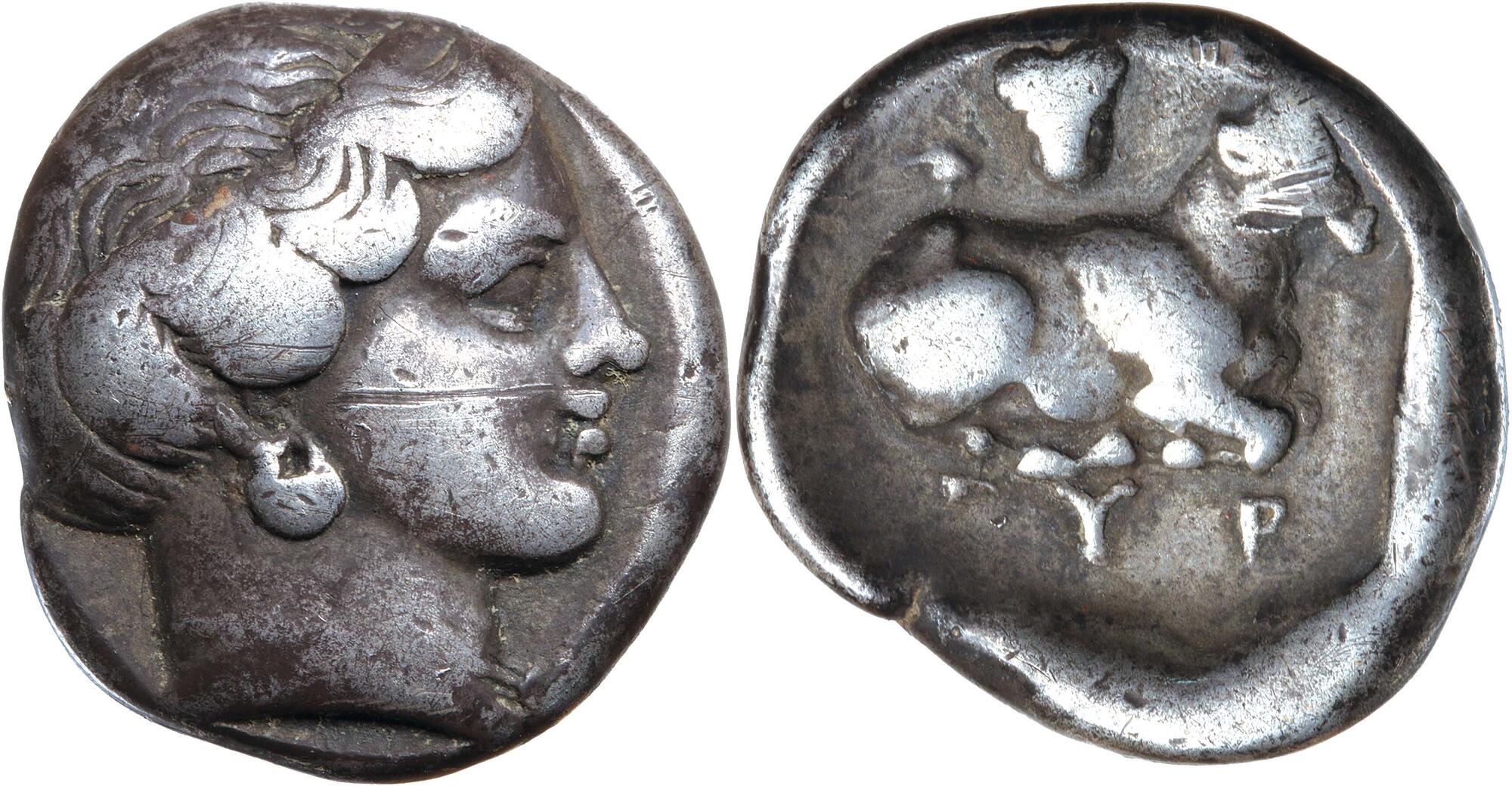Eretria, silver, staters (411-404 BCE)
From SILVER
411 BCE - 404 BCE Silver 1,202 kg
Description
| ObverseInscription or printing placed on the obverse.: | head of nymph Euboia to right, hair rolled, wearing round earring. |
| ReverseInscription or printing placed on the reverse.: | EYB (Greek).Cow seated to right, bunch of grapes above, [E]YB below all within incuse square. |
Mint and issuing power
| MintIdentifies the place of manufacture or issue of a numismatic object.: | Eretria | Ancient regionAncient region.: | Euboea | Modern countryModern country: Greece | AuthorityIdentifies the issuing power. The authority can be "pretended" when the name or the portrait of X is on the coin but he/she was not the issuing power. It can also be "uncertain" when there is no mention of X on the coin but he/she was the issuing power according to the historical sources: | Euboean League |
Chronology
| FromIdentifies the initial date in a range assigned in a numismatic context. | 411 BCE | toIdentifies the final date in a range assigned in a numismatic context.. | 404 BCE | PeriodTime period of the numismatic object.: Classical 480-323 BC |
Physical description
| MetalThe physical material (usually metal) from which an object is made.: | Silver |
Median weightMedian of the weights of numismatic objects (in grams). in grams | 12.09 | DenominationTerm indicating the value of a numismatic object. Examples: tetradrachm, chalkous, denarius.: | stater |
StandardStandard.: |
Image

AC186 Eretria.jpeg [1]
References
| Die study referencePublication of the study: | Wallace 19561Wallace 1956, n° 1-13. | ||
| Coin series referenceReference to coin series study: | Sear I2Sear I, n° 2462, RQEMAC3RQEMAC, n° 186, HGC 44HGC 4, n° 1412 | ||
Obverse dies distribution
| FrequencyFrequency of specimen in distribution. ᵖ | Number of obversesNumber of obverse dies. ᵖ (o) | % (o) | Number of coinsNumber of coins. (n) | % (n) | Die nameName(s) of the die(s). |
| 4 | 1 | 20 | 4 | 5.97 | 2 |
| 5 | 1 | 20 | 5 | 7.46 | 1 |
| 18 | 1 | 20 | 18 | 26.87 | 3 |
| 19 | 1 | 20 | 19 | 28.36 | 5 |
| 21 | 1 | 20 | 21 | 31.34 | 4 |
| Total | 5 of 5 | 100 | 67 of 67 | 100 |
Reverse dies distribution
no distribution is available
Quantification
| Number of obversesNumber of obverse dies. ᵖ (o) | 5 | Number of singletons (o1)The number of singleton coins. ᵖ | |
| Number of reverse diesNumber of reverse dies. (r) | 7 | Number of coinsNumber of coins. (n) | 67 |
| Coins per obverse dieNumber of coins per obverse die. (n/o) | 13.4 | Coins per reverse dieNumber of coins per reverse die. (n/r) | 9.57 |
| Reverse per obverse ratioRatio of obverse dies divided by reverse dies. (r/o) | 1.4 | Percentage of singletons (o1)number of coins (n) divided by the number of singletons (o1) ᵖ | % |
| Original number of dies (O) (Carter 1983 formula)The estimation of the number of coins according to Carter 1983 ᵖ | 4.97 | Coins struck if 20,000 as average productivity per dieCoins made if the average productivity for obverses (according to Carter) is 20,000. ᵖ | 99,400 |
| Original number of dies (O) (Esty 2011 formula)The estimation of the number of coins according to the singleton formula in Esty 2011 ᵖ (O) | 5.4 | Survival rate if 20,000 as average productivity per dieSurvival rate if average productivity is 20,000. ᵖ | 0.00067 |
| Coverage (o = % of O) (Esty 1984 formula)Esty 1984 - coverage (% of O) ᵖ (o = % of O) | % | Die productivity if survival rate 1/2,000Average productivity if survival rate is 1/2,000. ᵖ | 26,961.77 |
| Weight of silver (in kg) if 20,000 coins per die (O = Carter formula)Carter 1983 * Median weight * 20000 (*10 if gold or electrum) ᵖ | 1,202 kg <br /> 1,202 kg | Die productivity if survival rate 1/5,000Average productivity if survival rate is 1/5,000. ᵖ | 67,404.43 |
Remarks
Most likely one single workstation
References
- ^ Wallace, William P. (1956), The Euboian League and its coinage, Numismatic notes and monographs 134, New York, 180 p., 16 pl., n° 1-13.
- ^ Sear, David R. (1978), Greek coins and their values. Vol. I, Europe, London, xl, 316 p.
- ^ Callataÿ, François de (2003), Recueil quantitatif des émissions monétaires archaïques et classiques, Numismatique Romaine, Wetteren, VII + 267 p.
- ^ Hoover, Oliver D. (2014), Handbook of Greek Coinage Series 4. Northern and Central Greece : Achaia Phthiotis, Ainis, Magnesia, Malis, Oita, Perrhaibia, Thessaly, Akarnania, Aitolia, Lokris, Phokis, Boiotia, Euboia, Attica, Megaris and Corinthia, sixth to first centuries BC, Lancaster, lxxi, 563 p.